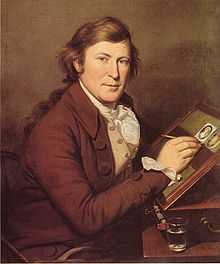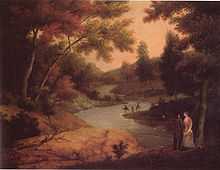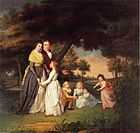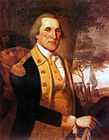James Peale
| James Peale | |
|---|---|
 James Peale Painting a Miniature by Charles Willson Peale | |
| Born |
1749 Chestertown, Maryland |
| Died | May 24, 1831 |
| Nationality | American |
| Education | Charles Willson Peale |
| Known for | Painting |
James Peale (1749 – May 24, 1831) was an American painter, best known for his miniature and still life paintings, and a younger brother of noted painter Charles Willson Peale.
Biography
Peale was born in Chestertown, Maryland, the second child, after Charles, of Charles Peale (1709–1750) and Margaret Triggs (1709–1791). His father died when he was an infant, and the family moved to Annapolis. In 1762 he began to serve apprenticeships there, first in a saddlery and later in a cabinetmaking shop. After his brother Charles returned from London in 1769, where he had studied with Benjamin West, Peale served as his assistant and learned how to paint.
Peale worked in his brother's studio until January 14, 1776, when he accepted a commission in the Continental Army as an ensign in William Smallwood's regiment. Within three months he was promoted to captain, and during the next three years fought in the battles of Long Island, White Plains, Trenton, Brandywine, Germantown, Princeton, and Monmouth. He resigned his army commission in 1779, and moved to Philadelphia to live with his brother. (One notable later collaboration, however, was in 1788 to make floats for Philadelphia's Federal Procession in honor of the newly drafted United States Constitution.)
Marriage

In 1782 he married Mary Claypoole (1753-1828), a daughter of James Claypoole (1721-1784) and sister of portrait painter James Claypoole Jr. (ca 1743-1822), after which he established his own household and artistic career. They had six children. James Peale, Jr.; Anna Claypoole Peale Duncan; Margaretta Angelica Peale; Sarah Miriam Peale; Maria Peale; and, Sophinisba Peale.[1]
Three of his six children became accomplished painters: Anna Claypoole Peale (1798–1871), a miniaturist and still-life painter; Margaretta Angelica Peale (1795–1882), painter of trompe l’oeil subjects and tabletop fruit; and Sarah Miriam Peale (1800–1885), a portraitist and still-life painter. His daughter Maria Peale also became a painter of still lifes, though of less distinction than her sisters.
Career

At the outset of his career Peale painted portraits and still-life, and by the mid-1780s had established his reputation. At about this time, however, Charles turned over his own miniature portrait practice to him, and throughout the 1790s and early 19th century Peale devoted himself to miniature painting. Much of this work was watercolor on ivory. In 1795 Peale exhibited a still life of fruit along with nine miniatures and his family portrait at the Columbianum, a short-lived art academy in Philadelphia. Around 1810, as Peale's eyesight began to weaken, he gave up painting miniatures to turn to large portraits and still-life subjects that were greatly admired and widely exhibited in Philadelphia, Boston, and Baltimore.
The total number of Peale's landscape paintings remains unknown, but he executed more than 200 watercolor miniatures on ivory, perhaps 100 still-life paintings, fewer than 70 oil portraits, and at least 8 history paintings.
Death
Peale died in Philadelphia on May 24, 1831 and is buried at Gloria Dei (Old Swedes') Church cemetery along with this wife and six children.[2]
References
- Miller, Lillian B. 'The Peale Family: Creation of a Legacy 1770-1870. Washington, D.C.: Abbeville Press, 1996.
Gallery
-

Still Life, oil on panel painting by James Peale, c. 1824, Honolulu Museum of Art
-

James Peale's oil painting 'Fruits of Autumn'
-

View on the Wissahickon
-

The Battle of Princeton, 1782
-

The Artist and His Family, 1795. Pennsylvania Academy of Fine Arts
-

Anna and Margaretta Peale
-

The Ramsay-Polk Family at Carpenter’s Point, Cecil County, Maryland
-

The Generals at Yorktown, Colonial Williamsburg Foundation
-

Sir Peter Parker's Attack Against Fort Moultrie, Colonial Williamsburg Foundation
-

The Ambush of Captain Allan McIane, 1803, Utah Museum of Fine Arts
-

Anna Sophia Alexander Robertson (Mrs. William Theberton), 1816
-

Portrait of William Young, 1817
External links
- American paintings & historical prints from the Middendorf collection, an exhibition catalog from The Metropolitan Museum of Art (fully available online as PDF), which contains material on Peale (no. 6)
- James Peale at Find a Grave
- Union List of Artist Names, Getty Vocabularies. ULAN Full Record Display for James Peale, Sr. Getty Vocabulary Program, Getty Research Institute. Los Angeles, California.
| Wikimedia Commons has media related to James Peale. |
|
